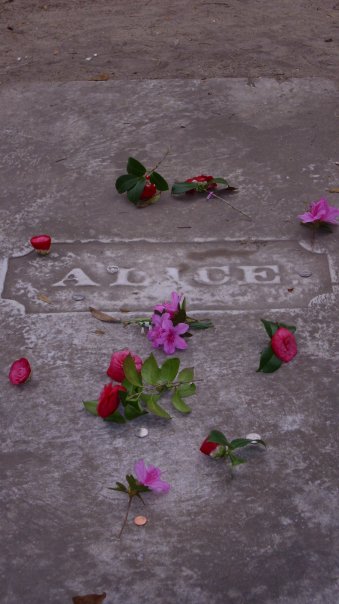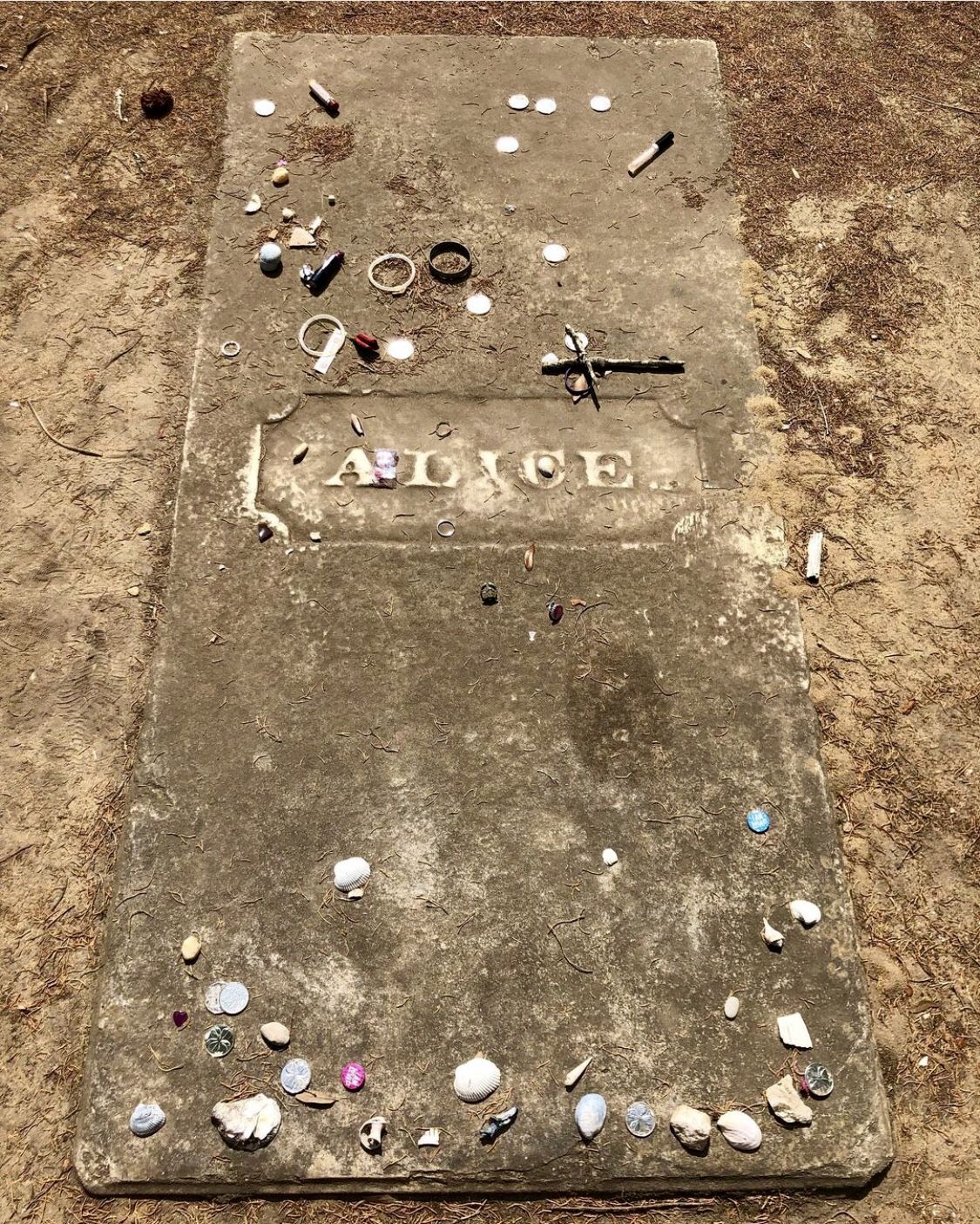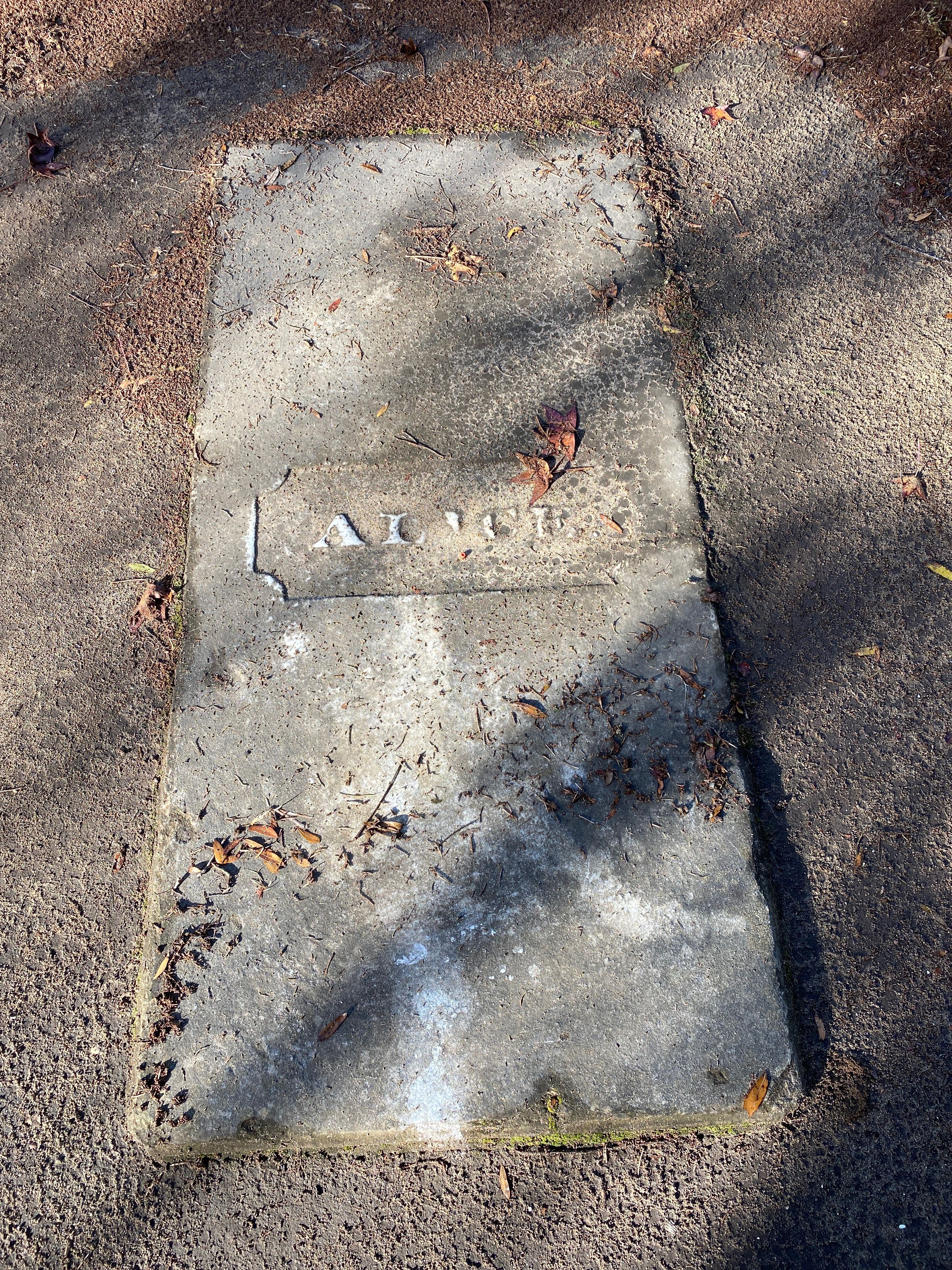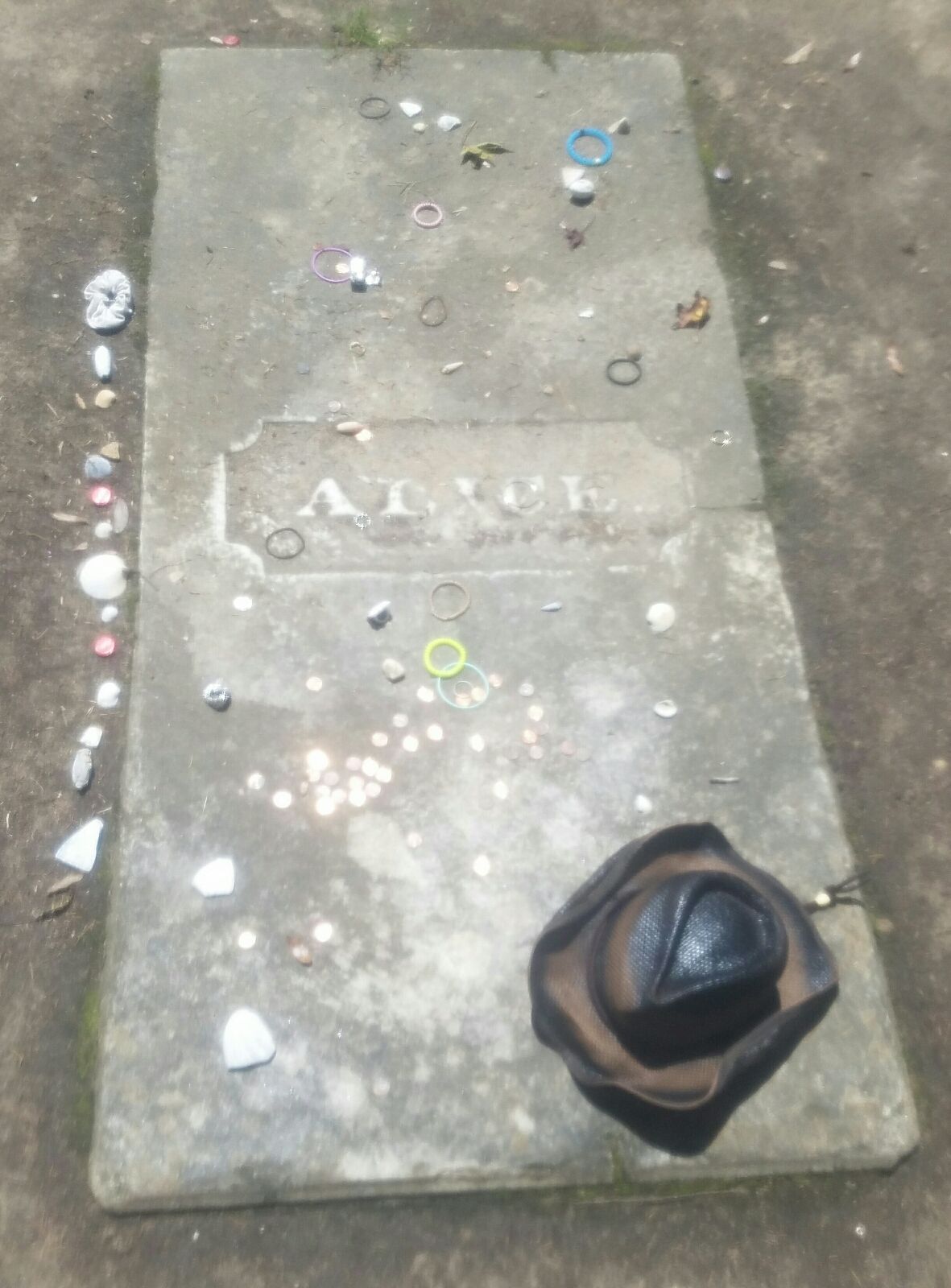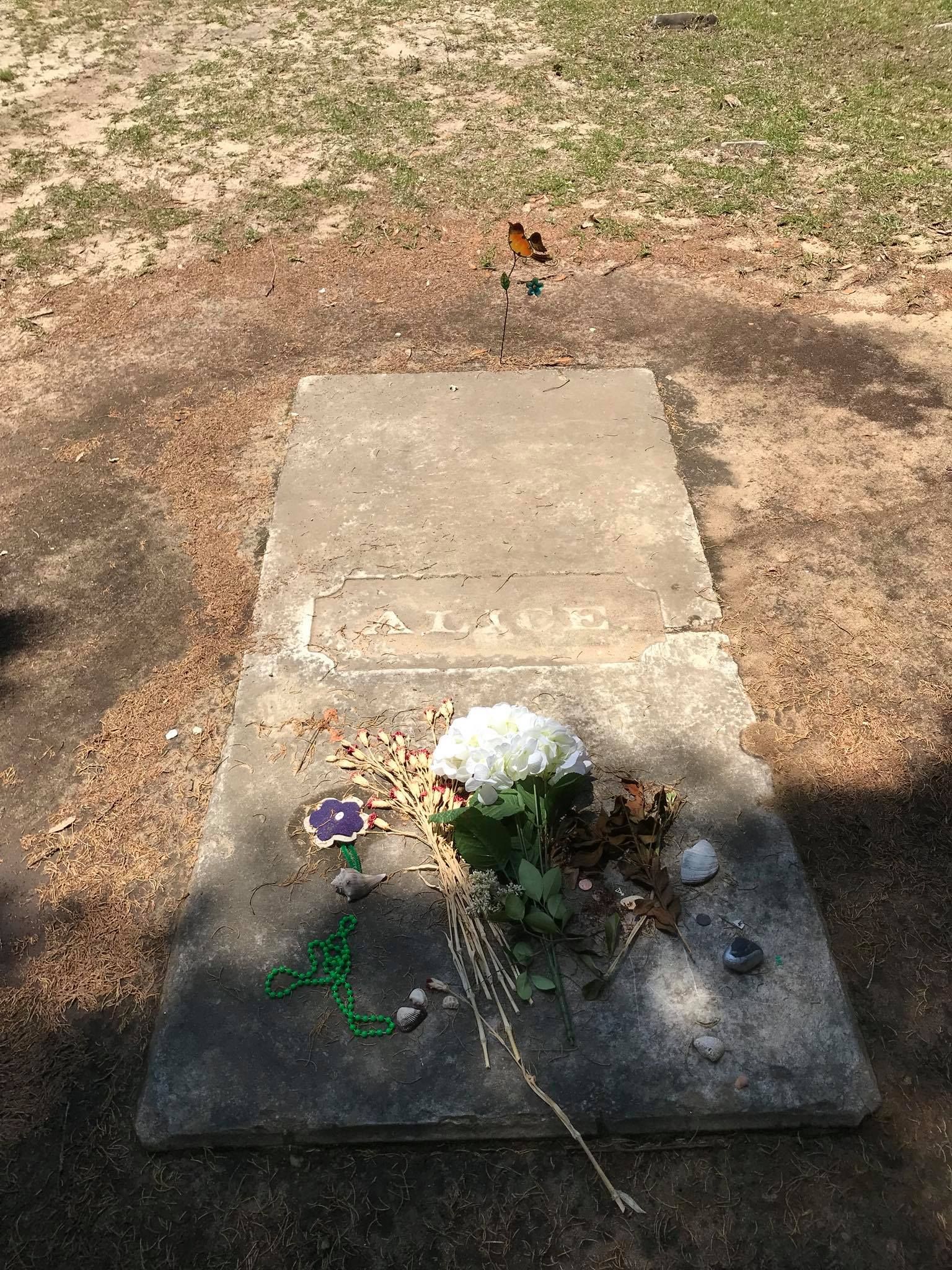----------------
It is a common story, the tale of Alice Flagg, but as one hears more details of this sad narrative, it becomes dazzling. For Alice Flagg is the most popular ghost on South Carolina's famed Grand Strand. The Alice Flagg story began in 1849 when she lived with her brother, Dr. Allard Flagg, and their mother in Murrells Inlet. They lived at The Hermitage, which was the seashore home of the owners of Wachesaw Plantation during the colonial period. This is a case of the mother and brother becoming deeply involved in the life of a young girl when she fell in love with a man believed to be beneath her station in South Carolina aristocracy.
The Hermitage: The house in Murrells Inlet where Alice Flagg died.
"Every woman must leave her mark on the earth," Alice's mother whispered to her. "And how can you etch on this earth anything that's worthwhile if you attach yourself to this common lumberman?"
But Alice was obsessed with her young man and paid scarce attention to her mother and her brother. However, on day when the tall, clean-cut lumberman came to call and Alice was about to step into the carriage with him, her brother stormed out of The Hermitage, and yelled, "Wait!"
He refused to allow Alice to ride with her young man, and he forced the lumberman to ride a horse while he, Dr. Flagg, sat in the carriage beside Alice. Alice felt she was suffering under the tyranny of her family, and she hotly resented their unrestrained exercise of power. She was wretched, and for all she could tell, her mother and brother didn't care!
While her mother and brother had extolled the virtues of falling in love with someone who would be a glorious addition to the Flagg family, Alice could not relate to their arguments, spoken with great fervor. She accepted an engagement ring from her true love. Dr. Allard Flagg staunchly refused to allow Alice to wear the ring on her finger, so she attached it to a ribbon and concealed it around her neck. As the days passed, she believed she was successful in concealing the ring. But one day her mother discovered the ring on her chest and another fighting match flared. The mother shouted that the lumberman was deplorable and plebeian and unfashionable as well -- worthy of no better wife than a common shop girl!
After suffering undue abuse, Alice was unable to persuade her mother and her brother to change their attitudes toward her betrothed, and under their bitter arguments she agreed to leave Murrells Inlet for Charleston where she would attend school.
But living in Charleston, with the change of terrain and the sensation of being alone in the pastel port city -- plus what seemed to be a lifetime of grief over her lost love -- took its toll on Alice. She became frail and listless and complained of some discomfort in the left side of her head. Lying on her bed, crying into her pillow, she carved in her mind a track of her life without the man she loved, and the track ended, always in a blur, an indistinct ending to her future. When she had first arrived in Charleston, she had been able to look with stark clarity on her predicament, but now it was blinding, a remarkable silence that she couldn't comprehend. Was she to survive this, she wondered.
One night, as she lay on her bed, although she was in a southern port city, she began to think that she was trying to walk in deep snow. It was a mystical experience as she pulled herself through deep white powder, struggling, and then, floating. The wilderness was on a grand scale of sky-high white spires, ancient glaciers and faraway valleys. Later that night, word went from the school that Alice had taken sick and should be sent to her home in Murrells Inlet.
When her brother received the word, he left at once in his carriage, but the way was long and arduous. Four days later he reached Charleston. He found Alice incredibly fatigued, with no strength to even nod to him. Her stamina had evaporated, and her nerves seemed in knots. He carried her to his carriage, and one of her friends packed her favorite dress for the journey. It was another four-day trip back home. The jostling and jolting as the carriage convulsed and bumped on the uneven roadway and across several rivers by ferry heightened Alice's nervousness. When she reached home, she was substantially weakened and soon lapsed into a coma and died.
Alice Flagg was dressed in her favorite dress for her funeral at All Saints Church, but her engagement ring had been taken away. Her corpse wasn't one of beauty. Her waxy face clearly showed the pain of losing her true love, and then, her life.
A plain marble slab, engraved ALICE, was placed over her burial mound.
Myriad friends and relatives say they have seen Alice's apparition at her home, The Hermitage at Murrells Inlet, and in the burial ground at All Saints Waccamaw Episcopal churchyard. It is believed that she comes back to search for her lost engagement ring.
When a group of young people stood at the gravesite of Alice Flagg, a ring suddenly flew off the finger of one of the girls. It took the group much of the day to locate the ring, which was treasured. The girl had been unable to remove the ring from her finger for several years due to a weight gain.∼
Formerly known as Cedar Hill Cemetery.
Her grave is not marked.
[NOTE from Findagrave Contributor 49085610, 29 Dec 2021: "There is considerable dispute about the memorial marked Alice at All Saints Episcopal cemetery. The slab bearing her first name is supposedly just a memorial, and her unmarked grave is at Belin Methodist in Murrells Inlet."]
----------------
It is a common story, the tale of Alice Flagg, but as one hears more details of this sad narrative, it becomes dazzling. For Alice Flagg is the most popular ghost on South Carolina's famed Grand Strand. The Alice Flagg story began in 1849 when she lived with her brother, Dr. Allard Flagg, and their mother in Murrells Inlet. They lived at The Hermitage, which was the seashore home of the owners of Wachesaw Plantation during the colonial period. This is a case of the mother and brother becoming deeply involved in the life of a young girl when she fell in love with a man believed to be beneath her station in South Carolina aristocracy.
The Hermitage: The house in Murrells Inlet where Alice Flagg died.
"Every woman must leave her mark on the earth," Alice's mother whispered to her. "And how can you etch on this earth anything that's worthwhile if you attach yourself to this common lumberman?"
But Alice was obsessed with her young man and paid scarce attention to her mother and her brother. However, on day when the tall, clean-cut lumberman came to call and Alice was about to step into the carriage with him, her brother stormed out of The Hermitage, and yelled, "Wait!"
He refused to allow Alice to ride with her young man, and he forced the lumberman to ride a horse while he, Dr. Flagg, sat in the carriage beside Alice. Alice felt she was suffering under the tyranny of her family, and she hotly resented their unrestrained exercise of power. She was wretched, and for all she could tell, her mother and brother didn't care!
While her mother and brother had extolled the virtues of falling in love with someone who would be a glorious addition to the Flagg family, Alice could not relate to their arguments, spoken with great fervor. She accepted an engagement ring from her true love. Dr. Allard Flagg staunchly refused to allow Alice to wear the ring on her finger, so she attached it to a ribbon and concealed it around her neck. As the days passed, she believed she was successful in concealing the ring. But one day her mother discovered the ring on her chest and another fighting match flared. The mother shouted that the lumberman was deplorable and plebeian and unfashionable as well -- worthy of no better wife than a common shop girl!
After suffering undue abuse, Alice was unable to persuade her mother and her brother to change their attitudes toward her betrothed, and under their bitter arguments she agreed to leave Murrells Inlet for Charleston where she would attend school.
But living in Charleston, with the change of terrain and the sensation of being alone in the pastel port city -- plus what seemed to be a lifetime of grief over her lost love -- took its toll on Alice. She became frail and listless and complained of some discomfort in the left side of her head. Lying on her bed, crying into her pillow, she carved in her mind a track of her life without the man she loved, and the track ended, always in a blur, an indistinct ending to her future. When she had first arrived in Charleston, she had been able to look with stark clarity on her predicament, but now it was blinding, a remarkable silence that she couldn't comprehend. Was she to survive this, she wondered.
One night, as she lay on her bed, although she was in a southern port city, she began to think that she was trying to walk in deep snow. It was a mystical experience as she pulled herself through deep white powder, struggling, and then, floating. The wilderness was on a grand scale of sky-high white spires, ancient glaciers and faraway valleys. Later that night, word went from the school that Alice had taken sick and should be sent to her home in Murrells Inlet.
When her brother received the word, he left at once in his carriage, but the way was long and arduous. Four days later he reached Charleston. He found Alice incredibly fatigued, with no strength to even nod to him. Her stamina had evaporated, and her nerves seemed in knots. He carried her to his carriage, and one of her friends packed her favorite dress for the journey. It was another four-day trip back home. The jostling and jolting as the carriage convulsed and bumped on the uneven roadway and across several rivers by ferry heightened Alice's nervousness. When she reached home, she was substantially weakened and soon lapsed into a coma and died.
Alice Flagg was dressed in her favorite dress for her funeral at All Saints Church, but her engagement ring had been taken away. Her corpse wasn't one of beauty. Her waxy face clearly showed the pain of losing her true love, and then, her life.
A plain marble slab, engraved ALICE, was placed over her burial mound.
Myriad friends and relatives say they have seen Alice's apparition at her home, The Hermitage at Murrells Inlet, and in the burial ground at All Saints Waccamaw Episcopal churchyard. It is believed that she comes back to search for her lost engagement ring.
When a group of young people stood at the gravesite of Alice Flagg, a ring suddenly flew off the finger of one of the girls. It took the group much of the day to locate the ring, which was treasured. The girl had been unable to remove the ring from her finger for several years due to a weight gain.∼
Formerly known as Cedar Hill Cemetery.
Her grave is not marked.
[NOTE from Findagrave Contributor 49085610, 29 Dec 2021: "There is considerable dispute about the memorial marked Alice at All Saints Episcopal cemetery. The slab bearing her first name is supposedly just a memorial, and her unmarked grave is at Belin Methodist in Murrells Inlet."]










